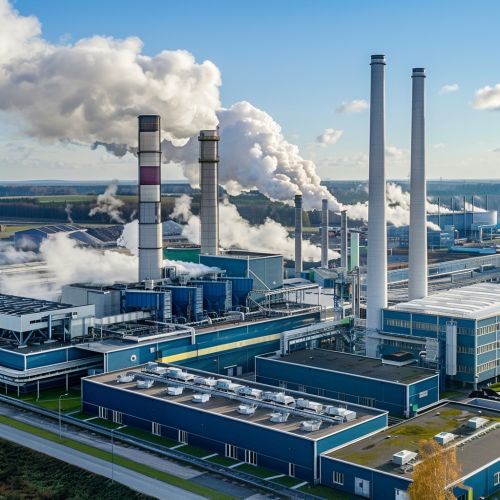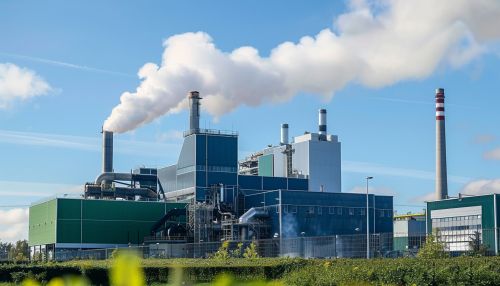Waste-to-Energy: Difference between revisions
No edit summary |
No edit summary |
||
| Line 8: | Line 8: | ||
Incineration is the most widely used waste-to-energy technology. It involves the combustion of organic materials found in waste. The process reduces the volume of waste by up to 90% and generates heat, which can be used to produce steam and electricity. Modern incineration plants are equipped with advanced air pollution control systems to minimize emissions of harmful substances such as dioxins, furans, and heavy metals. | Incineration is the most widely used waste-to-energy technology. It involves the combustion of organic materials found in waste. The process reduces the volume of waste by up to 90% and generates heat, which can be used to produce steam and electricity. Modern incineration plants are equipped with advanced air pollution control systems to minimize emissions of harmful substances such as dioxins, furans, and heavy metals. | ||
[[Image:Detail-92947.jpg|thumb|center|Modern waste incineration plant with smokestacks and energy recovery facilities.]] | [[Image:Detail-92947.jpg|thumb|center|Modern waste incineration plant with smokestacks and energy recovery facilities.|class=only_on_mobile]] | ||
[[Image:Detail-92948.jpg|thumb|center|Modern waste incineration plant with smokestacks and energy recovery facilities.|class=only_on_desktop]] | |||
=== Gasification === | === Gasification === | ||
Latest revision as of 20:17, 21 June 2024
Introduction
Waste-to-energy (WtE) is a process that involves the conversion of waste materials into usable forms of energy, such as electricity, heat, or fuel. This process is a part of the broader field of waste management and energy recovery, aiming to reduce the volume of waste and generate energy in an environmentally sustainable manner. Waste-to-energy technologies play a crucial role in modern waste management strategies by providing an alternative to landfilling and contributing to renewable energy production.
Technologies and Processes
Waste-to-energy encompasses a variety of technologies and processes, each with its own mechanisms and applications. The primary methods include incineration, gasification, pyrolysis, anaerobic digestion, and landfill gas recovery.
Incineration
Incineration is the most widely used waste-to-energy technology. It involves the combustion of organic materials found in waste. The process reduces the volume of waste by up to 90% and generates heat, which can be used to produce steam and electricity. Modern incineration plants are equipped with advanced air pollution control systems to minimize emissions of harmful substances such as dioxins, furans, and heavy metals.


Gasification
Gasification is a process that converts organic or fossil-based carbonaceous materials into carbon monoxide, hydrogen, and carbon dioxide. This is achieved by reacting the material at high temperatures (typically above 700°C) without combustion, with a controlled amount of oxygen and/or steam. The resulting gas mixture, known as syngas, can be used to produce electricity, chemicals, or fuels.
Pyrolysis
Pyrolysis involves the thermal decomposition of materials at elevated temperatures in an inert atmosphere. Unlike incineration, pyrolysis does not involve combustion. The process produces a mixture of solid residue (char), liquid (bio-oil), and gases. The bio-oil can be refined into various fuels, while the gases can be used to generate electricity.
Anaerobic Digestion
Anaerobic digestion is a biological process that breaks down organic matter in the absence of oxygen, producing biogas and digestate. The biogas, primarily composed of methane and carbon dioxide, can be used to generate electricity and heat or be upgraded to biomethane for use as a renewable natural gas. The digestate can be used as a nutrient-rich fertilizer.
Landfill Gas Recovery
Landfill gas recovery involves the collection and utilization of methane produced by the anaerobic decomposition of organic waste in landfills. Methane is a potent greenhouse gas, and capturing it for energy production helps mitigate its environmental impact. The collected gas can be used to generate electricity, heat, or be processed into renewable natural gas.
Environmental and Economic Impacts
Waste-to-energy technologies offer several environmental and economic benefits, but they also present challenges that need to be addressed.
Environmental Benefits
1. **Reduction of Greenhouse Gas Emissions:** By diverting waste from landfills and capturing methane, WtE technologies help reduce greenhouse gas emissions. 2. **Energy Recovery:** WtE processes convert waste into valuable energy, contributing to the renewable energy mix and reducing reliance on fossil fuels. 3. **Volume Reduction:** Incineration and other thermal processes significantly reduce the volume of waste, decreasing the need for landfill space.
Environmental Challenges
1. **Air Pollution:** Incineration and gasification can produce air pollutants, including particulate matter, heavy metals, and dioxins. Advanced pollution control technologies are essential to minimize these emissions. 2. **Residue Management:** The ash and other residues produced by WtE processes need to be managed and disposed of safely to prevent environmental contamination.
Economic Considerations
1. **Capital and Operational Costs:** WtE facilities require significant capital investment and operational costs. However, they can generate revenue through energy production and tipping fees for waste processing. 2. **Market for By-products:** The economic viability of WtE technologies can be enhanced by developing markets for by-products such as bio-oil, syngas, and digestate.
Policy and Regulation
The development and operation of waste-to-energy facilities are influenced by various policies and regulations at the local, national, and international levels.
International Frameworks
1. **European Union:** The EU has established directives such as the Waste Framework Directive and the Renewable Energy Directive, which promote waste-to-energy as part of a circular economy and renewable energy strategy. 2. **United States:** In the US, the Environmental Protection Agency (EPA) regulates WtE facilities under the Clean Air Act and the Resource Conservation and Recovery Act.
National and Local Policies
Countries and municipalities have developed specific policies to support the implementation of WtE technologies. These policies often include incentives for renewable energy production, waste diversion targets, and stringent environmental standards.
Technological Innovations
Recent advancements in waste-to-energy technologies are enhancing efficiency, reducing environmental impacts, and expanding the range of feedstocks that can be processed.
Advanced Thermal Conversion
Innovations in thermal conversion technologies, such as plasma gasification and advanced pyrolysis, are improving the efficiency and environmental performance of WtE processes. Plasma gasification uses an electric arc to generate extremely high temperatures, breaking down waste into its basic molecular components.
Biochemical Conversion
Advances in biochemical conversion, including the development of more efficient anaerobic digestion processes and genetically engineered microorganisms, are increasing the yield and quality of biogas and other biofuels.
Integration with Renewable Energy Systems
Integrating WtE facilities with other renewable energy systems, such as solar and wind power, can enhance the overall sustainability and reliability of energy production. Hybrid systems can provide a continuous energy supply by compensating for the intermittent nature of solar and wind energy.
Case Studies
Several countries and cities have successfully implemented waste-to-energy projects, demonstrating the potential and challenges of these technologies.
Sweden
Sweden is a global leader in waste-to-energy, with over 50% of its household waste being converted into energy. The country has developed an extensive network of incineration plants equipped with advanced pollution control technologies. Sweden's success is attributed to strong policy support, public acceptance, and a well-developed waste management infrastructure.
Singapore
Singapore has implemented a comprehensive waste-to-energy strategy to manage its limited land resources. The Tuas South Incineration Plant, one of the largest in the world, processes over 3,000 tons of waste daily and generates electricity for the national grid. The plant is equipped with state-of-the-art emissions control systems to ensure compliance with stringent environmental standards.
United States
The United States has a diverse range of waste-to-energy facilities, including incineration plants, anaerobic digesters, and landfill gas recovery systems. The Covanta Energy-from-Waste facility in Fairfax County, Virginia, is one of the largest in the country, processing over 3,000 tons of waste per day and generating enough electricity to power 80,000 homes.
Future Prospects
The future of waste-to-energy technologies is shaped by ongoing research, policy developments, and market trends.
Research and Development
Continued research and development are essential to address the technical and environmental challenges of WtE technologies. Areas of focus include improving the efficiency of thermal and biochemical conversion processes, developing new materials for pollution control, and exploring novel feedstocks such as plastic waste and agricultural residues.
Policy and Market Trends
The adoption of circular economy principles and the increasing emphasis on renewable energy are driving the growth of the waste-to-energy sector. Policies that promote waste reduction, recycling, and energy recovery are critical to the sustainable development of WtE technologies. Market trends, such as the rising demand for renewable energy and the development of carbon markets, also play a significant role in shaping the future of the industry.
Conclusion
Waste-to-energy technologies offer a viable solution for managing waste and generating renewable energy. While there are environmental and economic challenges to address, advancements in technology and supportive policies are paving the way for a more sustainable future. By integrating WtE processes into comprehensive waste management strategies, societies can reduce their environmental footprint and contribute to a circular economy.
